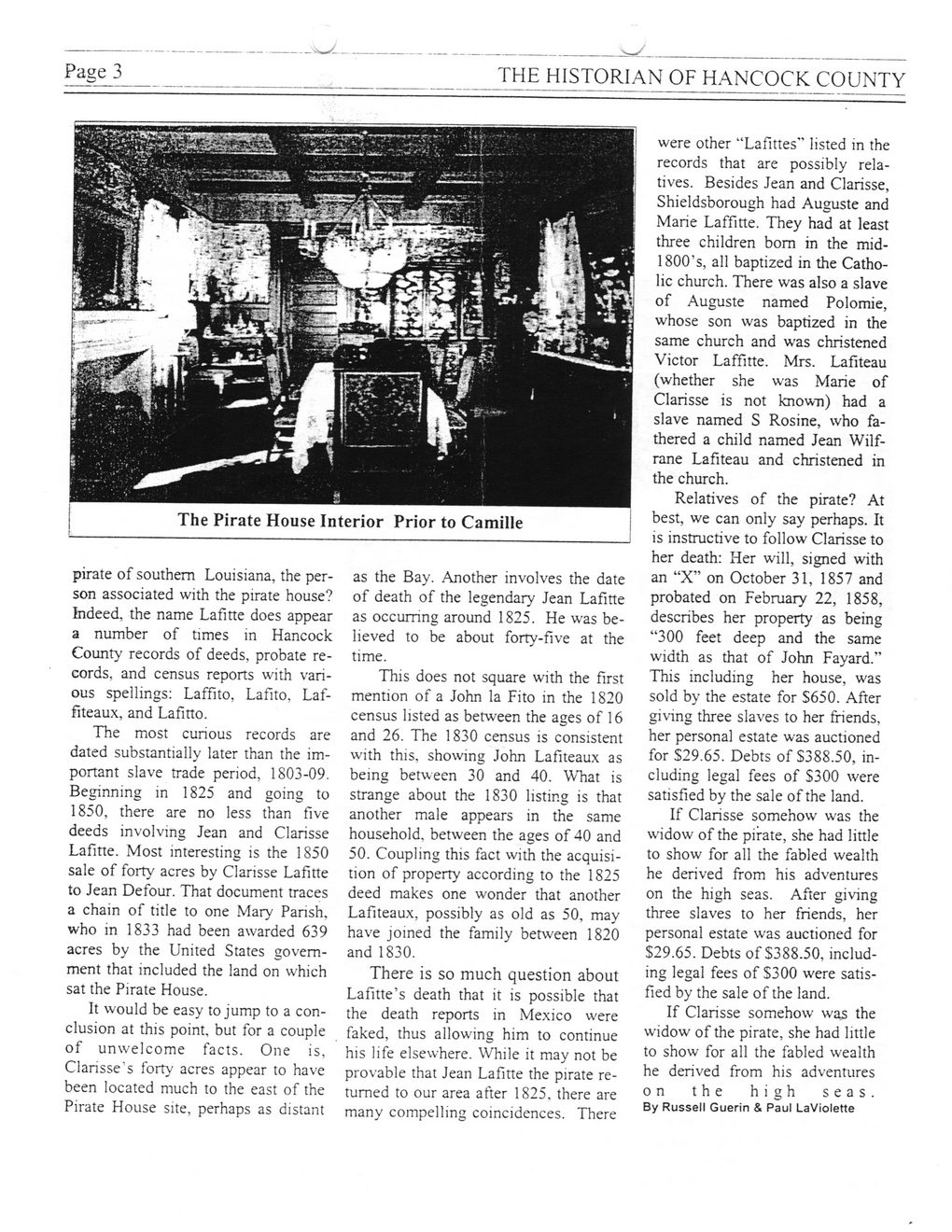This text was obtained via automated optical character recognition.
It has not been edited and may therefore contain several errors.
Page 3 THE HISTORIAN OF HANCOCK COUNTY pirate of southern Louisiana, the person associated with the pirate house? Indeed, the name Lafitte does appear a number of times in Hancock County records of deeds, probate records, and census reports with various spellings: Laffito, Lafito, Laf-fiteaux, and Lafitto. The most curious records are dated substantially later than the important slave trade period, 1803-09. Beginning in 1825 and going to 1850, there are no less than five deeds involving Jean and Clarisse Lafitte. Most interesting is the 1850 sale of forty acres by Clarisse Lafitte to Jean Defour. That document traces a chain of title to one Mary Parish, who in 1833 had been awarded 639 acres by the United States government that included the land on which sat the Pirate House. It would be easy to jump to a conclusion at this point, but for a couple of unwelcome facts. One is, Clarisse’s forty acres appear to have been located much to the east of the Pirate House site, perhaps as distant as the Bay. Another involves the date of death of the legendary Jean Lafitte as occumng around 1825. He was believed to be about forty-five at the time. This does not square with the first mention of a John la Fito in the 1820 census listed as between the ages of 16 and 26. The 1830 census is consistent with this, showing John Lafiteaux as being between 30 and 40. What is strange about the 1830 listing is that another male appears in the same household, between the ages of 40 and 50. Coupling this fact with the acquisition of property according to the 1825 deed makes one wonder that another Lafiteaux, possibly as old as 50, may have joined the family between 1820 and 1830. There is so much question about Lafitte’s death that it is possible that the death reports in Mexico were faked, thus allowing him to continue his life elsewhere. While it may not be provable that Jean Lafitte the pirate returned to our area after 1825, there are many compelling coincidences. There were other “Lafittes” listed in the records that are possibly relatives. Besides Jean and Clarisse, Shieldsborough had Auguste and Marie Laffitte. They had at least three children bom in the mid-1800’s, all baptized in the Catholic church. There was also a slave of Auguste named Polomie, whose son was baptized in the same church and was christened Victor Laffitte. Mrs. Lafiteau (whether she was Marie of Clarisse is not known) had a slave named S Rosine, who fathered a child named Jean Wilf-rane Lafiteau and christened in the church. Relatives of the pirate? At best, we can only say perhaps. It is instructive to follow Clarisse to her death: Her will, signed with an “X” on October 31, 1857 and probated on February 22, 1858, describes her property as being “300 feet deep and the same width as that of John Fayard.” This including her house, was sold by the estate for S650. After giving three slaves to her friends, her personal estate was auctioned for S29.65. Debts of S388.50, including legal fees of S300 were satisfied by the sale of the land. If Clarisse somehow was the widow of the pirate, she had little to show for all the fabled wealth he derived from his adventures on the high seas. After giving three slaves to her friends, her personal estate was auctioned for $29.65. Debts of $388.50, including legal fees of $300 were satisfied by the sale of the land. If Clarisse somehow was the widow of the pirate, she had little to show for all the fabled wealth he derived from his adventures on the high seas. By Russell Guerin & Paul LaViolette

Pirate House Document (091)